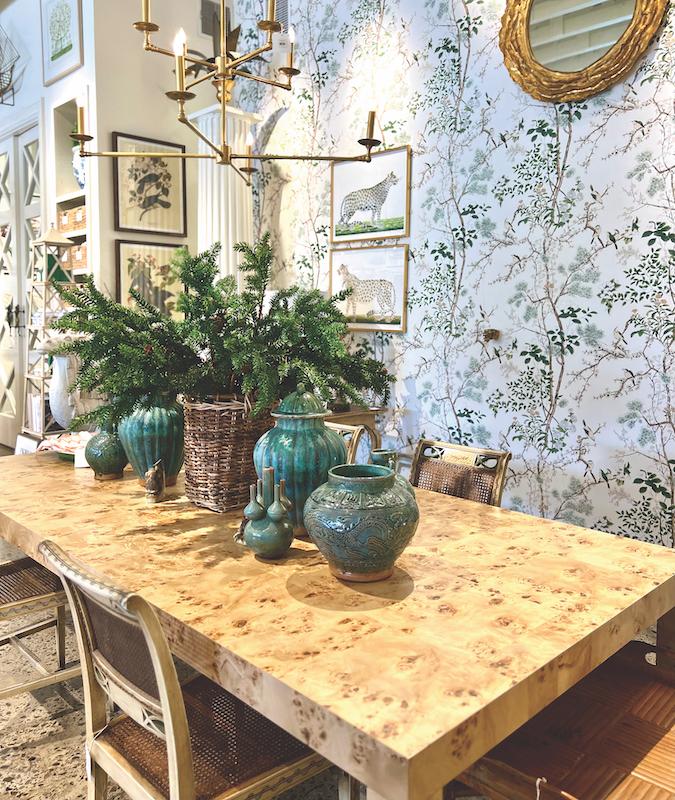In the ever-evolving realm of interior design and retail, merchandising and staging strategies have become the secret weapons driving success. With fierce competition and discerning customers, it’s important to highlight the transformative power of merchandising and staging — and shed light on the strategic tactics that both leave a lasting impression and boost sales.
Retailers can employ ever-changing concepts throughout the year to keep customers engaged and curious. By developing cross-merchandising opportunities that tell a story, retailers can also foster add-on sales according to Michelle Sherrier, host and creator of “The Retail Whore” podcast. After decades spent within the industry, Sherrier has seen and done it all, and often emphasizes the power of creative merchandising as a means to “wow” customers.
“Your number one tactic should be creative merchandising,” Sherrier says. “For example, we created a ‘bee’ concept for a client last summer. We used melamine dishes with bees and florals, beeswax candles, dish towels with bees, cookbooks that were on baking, salt and pepper shakers that played off the bee theme, etc.”
These bee-inspired products were also complemented by DIY additions, highlighting the significance of storytelling through various elements.
“We handmade oversized bees out of styrofoam balls, hung them above and used the honey in the little bear bottle as a prop,” she says. “By creating cute props and cross-merchandising, we developed a more interesting display that also created add-on sales.”
From the risers on which merchandise is displayed to the props used to enhance products, every detail contributes to the narrative, according to Sherrier. She also suggests using props that are not necessarily expensive, but carry significant symbolic weight. For instance, a display featuring real French bread on a cutting board, accompanied by a cookbook on charcuterie boards, can vividly convey a story to customers.
“The bread dries beautifully and costs next to nothing,” she says. “I don’t allow plastic risers — on the podcast, I talk a lot about my hatred of them. Why use them when you could use something that will help you to continue to tell a story? A display of garden pots, faux flowers and coffee table books on French gardens look so much more rich. Not expensive, but incredibly impactful to your storytelling.”
Similarly Coco & Dash, a home decor retail shop and interior design firm, utilizes telling a captivating story as an art form. At the heart of their approach is a deep appreciation for the human connection within the retail experience, fostering a genuine love for the concept of home.
Teddie Garrigan, co-owner of Coco & Dash, along with her partner and daughter Courtney Garrigan, strive to showcase the importance of unpretentious luxury, style and comfort in everyday living.
“Through the storytelling of our merchandising we align directly with our brand story which is the foundation of
every buying, display and design decision,” Teddie Garrigan says. “At Coco & Dash we consider ourselves producers of retail theater.”
The Garrigans love to bring their vision into focus to help customers see what they see, focusing on people and the human dynamic in retail.
“How do customers experience the store? What are their expectations?,” Garrigan continues. “We’ve created a retail concept that incorporates product, physical space and atmosphere. Each component is equally important in sparking a customer’s creative curiosity, which is what makes people excited. Every piece is personally selected by us with a clear vision of how our customers will relate to it.”
On the design side, the Garrigans “wow” their clients by envisioning their living spaces, and embracing the unique architecture and surroundings of each client’s home. By carefully selecting furnishings and accessories that retain their beauty over time, Coco & Dash creates spaces that are both stylish and enduring.
“Delivering a home that is uniquely comfortable and comforting to the people who live there is the most rewarding aspect of our design process,” Garrigan says. “We find that people are happiest when they know we truly understand how they want to live. Delivering spaces of exceptional style that are functional and bring joy to the people who live in them is always the end game.”
Adding finishing touches are also key to achieving a truly remarkable design. Beyond primary furnishings, Garrigan says she ensures her customers have special accessories, window treatments, bespoke lampshades and more to give them the perfect foundation from which to grow.
Movement & Reinvention
Periodically moving or “reinventing” products within a store to maintain customer engagement and drive sales is also important, according to Sherrier. By shifting merchandise to different locations or reimagining their presentation, retailers can avoid products being overlooked or lost amidst the shuffle. Sherrier has witnessed the transformative impact of showcasing products in completely new ways.
“Sometimes customers don’t walk the entire store, so items are missed,” she says. “Sometimes, the product is in a dead space. Sometimes the product is lost in a display with too much merchandise. When you reimagine the product, it gives the message that it’s new and fresh when in fact it is the exact same product.”
Sherrier also suggests changing focal tables and displays every few weeks.
“Focal is what you see from the front door,” she says. “For the customer who shops with you all the time, if she walks by and looks in and sees the same display and product in the front week after week, she will stop coming in. Why? Because you are telling her that nothing is new. These focal spaces need to look fresh and new all the time.”
At Design House & Fabric House, decor showrooms and luxury interior design firm in Houston, TX, owner Connie LeFevre says rotating new products — like various unique accessories — ensures continual interest within the showroom. For this reason, Design House consistently keeps new accessories coming in.
“Those are easier for us to move around in a new setting,” she says. “When a designer comes in and they’re installing a project, they’re always without accessories. One of them can come in and almost wipe us out! So we always have those in rotation.”
Since Design House sells merchandise off the floor, the group is constantly rotating settings — though with supply chain issues, this has sometimes proven challenging. In cases like these, LeFevre emphasizes a change in buying habits.
“We have to monitor where we’re buying from and constantly stay abreast of that,” she says. “All while still curating and bringing in what we think is important and the customer will appreciate. Because we’re designers, we’re not just sales. We’re here to help people solve their problems and create their environments.”
Similarly, to keep the retail experience fresh and engaging, Coco & Dash performs a complete store reset twice a year, allowing for the expression of creativity and the introduction of fresh ideas while maintaining their signature aesthetic.
“Between those monster moves, we continually reimagine how products can be used by staying in design mode with small tweaks,” Garrigan says. “Products take on a new life when shown in different vignettes.”
When shifting decor for holidays and special events, Sherrier highlights the importance of creating a festive atmosphere without going overboard. For holidays such as Christmas, incorporating red grosgrain ribbons with sprigs of green on everyday candles or using greens and lighting elements can infuse a sense of holiday spirit into the store. Sherrier draws from her experience at Anthropologie, where the “sight, sound and scent” philosophy was employed to create a magical experience.
“The smell of pine or a fireplace, the lights and hopefully a little holiday music all create holiday magic and sales,” she says. “You want your store to feel festive and to create the feeling of the holiday. It gives the customer a subliminal cue that they need to pick up a gift for a friend or family member as well as gets people in the holiday spirit.”
Additionally, Sherrier suggests leveraging plants, flowers and embellishments to create a festive ambiance for other holidays, enhancing the product while maintaining a modest investment. By harnessing these tactics, retailers and designers can create immersive experiences, keeping customers engaged, inspired and eager to explore the narratives woven within their stores.







